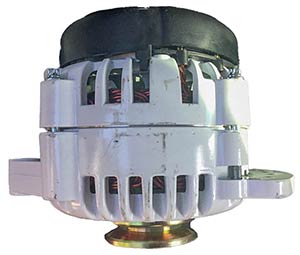September 5, 2022
We’ve had a Balmar alternator on Legacy for the past 20+ years but with this last failure, I think I’ve finally found a better solution.
What’s gone wrong…
On our first trip to Hawaii from Los Angeles, the rear bearing failed. Since the alternator belt also drives the fresh water pump, we couldn’t run our engine to get into Radio Bay. I did a MacGyver and was able to get a few hours of run time when we needed it most.
I don’t know that I can blame Balmar for this failure. I don’t know how old the alternator was as it was on Legacy when we bought her. We ordered lots of extra parts for the alternator (this was back when Balmar supported their products by selling spares), as well as a new, complete Balmar alternator.
On the way back from Hawaii, the new Balmar Alternator quit producing power. Keep in mind that this was a new alternator. I took it apart and found the rotor failed. We unwound the wire, found the break near the center, soldered it, rewound it and made it back to Los Angeles. We had lots of spares, but no spare rotor. Why would anyone carry that?
About half way into our current Pacific cruise, we had another Balmar fail. I really don’t remember what the problem was that time. I think the stator windings shorted.
About a month ago, in New Caledonia, we had another Balmar failure. I put our old Hitachi stock alternator on (that we carried as a spare) and had the Balmar serviced in New Cal by an automotive electrical shop. They found broken connections from the stator and silver soldered them.
I no longer trusted it…
I’ve always been bothered by the low output once the alternator was hot and just how hot the alternator was getting. At best, once the alternator was up to temperature, we’d see about 60 amps out of our 100 amp alternator. All of them have been this way. Our 60 amp Hitachi was putting out a constant 50 amps when hot and it wasn’t getting nearly as hot as the Balmar.
The Balmar would exceed the 107C limit set in the regulator. The regulator would reduce the power to about 50% for two or so minutes, then take it back to full power and in another two or three minutes the cycle would repeat. If we say 2 minutes at 50% and three minutes at full power, that amounts to a continuous 80% and 80% of 60 amps is only 48 amps.
Maybe that’s the way all small-frame alternators are, I wondered. Nope.
Recently, I bought and installed a 120 amp Bosch alternator and wow, what a difference! The full story is here, but now we get a continuous 100 amps and the highest alternator temperature I’ve seen is 88C. I’ve been told that the reason for this is that the Bosch alternator is much more efficient, in both energy production and cooling. I believe it.
Another big advantage was the price. The fully marinized Bosch alternator I bought from SmartRegulator in New Zealand was about $330 USD. The lowest price Balmar 100 amp alternator I can find online in Australia (where we are now) is about $915 USD. That’s almost a three for one deal!
The Bosch alternator is standard on many cars and trucks (like Ford trucks) and so, I expect parts and service to be easy to find. I’ve heard that Balmar is no longer selling parts for their alternators and you have to send it to them for service.
I think so many boaters buy into the Balmar myth. Not me… No more.
-Rich






